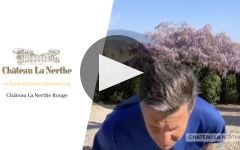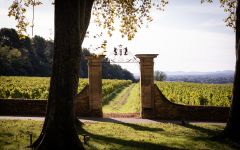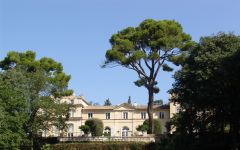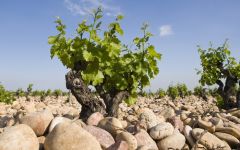Chateau La Nerthe Chateauneuf-du-Pape Rouge 2017
-
Wine
Enthusiast -
Tasting
Panel -
Wine
Spectator -
James
Suckling -
Robert
Parker



Product Details
Your Rating
Somm Note
Winemaker Notes
This deep red Châteauneuf du Pape is very aromatic. At the very begining, the nose is very red fruit driven and then, after a couple of minutes, it becomes more spicy (sweet asian spices and pot ourri). The mouth is full of energy, very juicy. Lots of garrigue characters, herbal notes but still very fleshy. The palate is soft and dense bringing an intense sappy finish.
Professional Ratings
-
Wine Enthusiast
Ripe, luminous wild strawberries and black cherry flavors explode from nose to finish in this hedonistic, intensely fruity blend of Grenache, Syrah, Mourvèdre and Cinsault. It's gorgeously primary in youth with a zesty mineral undertone, but is concentrated enough to improve, gaining earthier complexities through 2030 and likely further.
-
Tasting Panel
Spanning 225 acres, Château La Nerthe’s vineyards occupy a single block that has been certified organic since 1998. Their sandy clay soils boast a surface layer of the famous large, round stones called galets. All 14 of the appellation’s permitted varieties are planted here, though 62% of the vines—which average over 40 years old—are Grenache. Offering focused aromas of rhubarb, orange peel, and iron, this spiced expression has abundant personality defined by cinnamon and cranberry: It’s juicy, fresh, and vibrant, with a chewy texture and an earthy nature.
-
Wine Spectator
This pumps ripe raspberry, plum and blackberry pâte de fruit flavors through, with anise, fruitcake and Christmas pudding notes adding range and detail along the way. Flash of bay on the finish. A not-shy wine. Grenache, Syrah, Mourvèdre and Cinsault. Best from 2022 through 2032.
-
James Suckling
A very vibrant array of ripe raspberry, red-plum and berry-pastry aromas with mulberries, too. Very fresh. There’s a very rich and ripe, dark-fruit core here with a wealth of super plush and languid tannins that are dense yet soft. This is a hallmark of the vintage. A blend of 45% grenache, 30% syrah, 15% mourvedre and ten additional varieties. Drink over the next decade and more.
-
Robert Parker's Wine Advocate
The 2017 Chateauneuf du Pape features gentle herb shadings, ripe stone fruit and berry flavors, and a long, clean finish. It's full-bodied but somewhat delicate and silky in feel. I'd opt for drinking this blend of 35% Syrah, 30% Grenache, 30% Mourvèdre and 5% Cinsault over the next 7-8 years.
Other Vintages
2020-
James
Suckling - Vinous
-
Wine
Spectator
- Decanter
-
Robert
Parker -
James
Suckling - Vinous
-
Wine
Spectator -
Jeb
Dunnuck
-
Robert
Parker -
Jeb
Dunnuck
-
Jeb
Dunnuck -
James
Suckling -
Wine
Spectator -
Wine
Enthusiast -
Robert
Parker
-
Wine &
Spirits -
James
Suckling -
Robert
Parker -
Wine
Spectator
-
Wine &
Spirits
-
Wine &
Spirits -
Wine
Spectator
-
Wine
Spectator -
Wilfred
Wong
-
Wilfred
Wong -
Robert
Parker
-
Robert
Parker -
Wine &
Spirits -
Wine
Spectator -
Wine
Enthusiast
-
Wine
Spectator -
Robert
Parker
-
Wine &
Spirits -
Wine
Spectator
-
Robert
Parker -
Wine
Enthusiast
-
Wine
Spectator -
Robert
Parker
-
Wine &
Spirits -
Wine
Spectator
-
Wine &
Spirits
-
Wine
Spectator
-
Wine
Spectator -
Robert
Parker
-
Wine
Spectator
-
Robert
Parker
-
Robert
Parker









Archives affirm Chateau La Nerthe’s existence as early as 1560, while suggesting an even more distant past dating to the dawn of the region’s wine culture in the 12th century making it one of Chateauneuf’s oldest estates. Located in the heart of the Chateauneuf-du-Pape AOC region of southern France not far from Avignon, the 225 acres of Chateau La Nerthe vineyards are located in a single block around the Chateau and have been certified Organic since 1998. The terroir is very typical for the region: vineyards runs along a slope, at the top of which the vines dig their roots into soils of sandy-clay, on the surface there is a layer of the famous galettes, large, round, well-worn stones that originated in the Alps, having been carried down to the Rhône by the glaciers of previous ice ages. The further down the slope of the vineyard you travel, the more these stones dominate. All 14 of the permitted primary varietals are planted-Grenache dominates 62% of vineyards and the vines average over 40 years old. Chateau La Nerthe is the prime expression of Chateauneuf-du-Pape.

With bold fruit flavors and accents of sweet spice, Grenache, Syrah and Mourvèdre form the base of the classic Rhône Red Blend, while Carignan, Cinsault and Counoise often come in to play. Though they originated from France’s southern Rhône Valley, with some creative interpretation, Rhône blends have also become popular in other countries. Somm Secret—Putting their own local spin on the Rhône Red Blend, those from Priorat often include Merlot and Cabernet Sauvignon. In California, it is not uncommon to see Petite Sirah make an appearance.

Famous for its full-bodied, seductive and spicy reds with flavor and aroma characteristics reminiscent of black cherry, baked raspberry, garrigue, olive tapenade, lavender and baking spice, Châteauneuf-du-Pape is the leading sub-appellation of the southern Rhône River Valley. Large pebbles resembling river rocks, called "galets" in French, dominate most of the terrain. The stones hold heat and reflect it back up to the low-lying gobelet-trained vines. Though the galets are typical, they are not prominent in every vineyard. Chateau Rayas is the most obvious deviation with very sandy soil.
According to law, eighteen grape varieties are allowed in Châteauneuf-du-Pape and most wines are blends of some mix of these. For reds, Grenache is the star player with Mourvedre and Syrah coming typically second. Others used include Cinsault, Counoise and occasionally Muscardin, Vaccarèse, Picquepoul Noir and Terret Noir.
Only about 6-7% of wine from Châteauneuf-du-Pape is white wine. Blends and single-varietal bottlings are typically based on the soft and floral Grenache Blanc but Clairette, Bourboulenc and Roussanne are grown with some significance.
The wine of Chateauneuf-du-Pape takes its name from the relocation of the papal court to Avignon. The lore says that after moving in 1309, Pope Clément V (after whom Chateau Pape-Clément in Pessac-Léognan is named) ordered that vines were planted. But it was actually his successor, John XXII, who established the vineyards. The name however, Chateauneuf-du-Pape, translated as "the pope's new castle," didn’t really stick until the 19th century.
